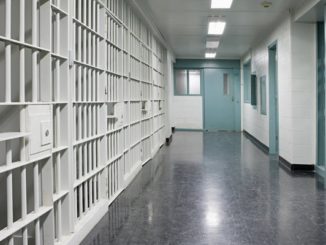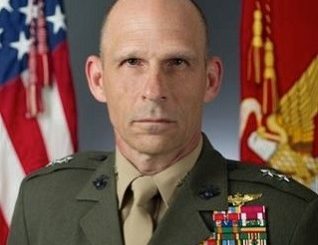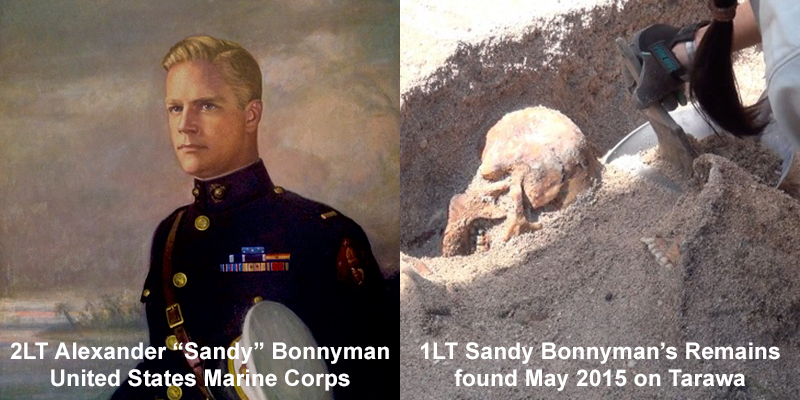
The Battle of Tarawa was a battle in the Pacific Theater of World War II fought on 20–23 November 1943. It took place at the Tarawa Atoll in the Gilbert Islands, and was part of Operation Galvanic, the U.S. invasion of the Gilberts. It’s estimated that nearly 6,400 Japanese, Koreans, and Americans died in the fighting, mostly on and around the small island of Betio, in the extreme southwest of Tarawa Atoll.
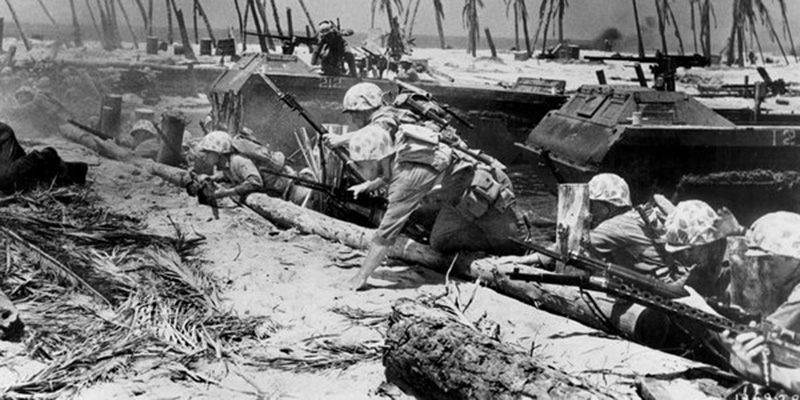
Naval doctrine of the time held that in order for attacks to succeed, land-based aircraft would be required to weaken the defenses and protect the invasion forces. The nearest islands capable of supporting such an effort were the Marshall Islands, northeast of Guadalcanal. Taking the Marshalls would provide the base needed to launch an offensive on the Marianas, but the Marshalls were cut off from direct communications with Hawaii by a Japanese garrison and air base on the small island of Betio, on the western side of Tarawa Atoll in the Gilbert Islands. Thus, to eventually launch an invasion of the Marianas, the battle had to start far to the east, at Tarawa.
The Battle of Tarawa was the first American offensive in the central Pacific region. It was also the first time in the Pacific War that the United States had faced serious Japanese opposition to an amphibious landing. Previous landings met little or no initial resistance, but on Tarawa the 4,500 Japanese defenders were well-supplied and well-prepared. They fought almost to the last man, exacting a heavy toll on the United States Marine Corps. America had lost many men on previous campaigns such as Guadalcanal. The difference was the men who were lost on Guadalcanal spanned a six month period, and the men lost on Tarawa were during a period of 76 hours.
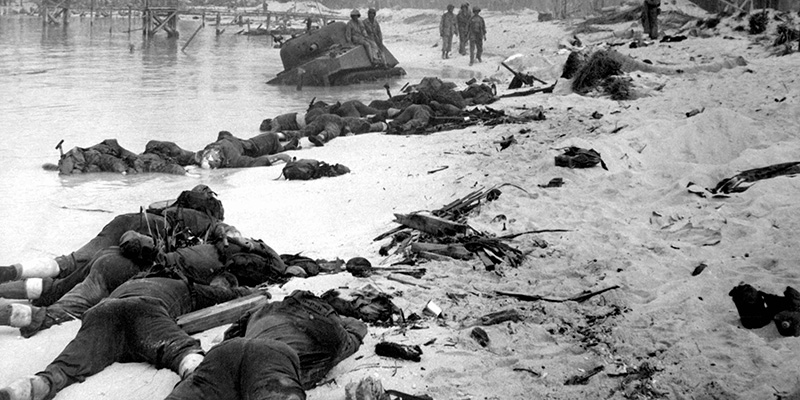
The loss of American lives on Tarawa was terribly embarrassing for the military. There are some who believe the casualty numbers may have been “adjusted” so the American people could swallow the bitter-pill of pictures showing hundreds of American dead on the beaches of Tarawa.
Tarawa was one of the first battles to be filmed in color. The images of American corpses decaying on the beaches of Tarawa were politically corrosive for the American people who were praying for a swift end to the war. Consequently, it’s suspected the American death toll from Tarawa was artificially minimized, and the Japanese death toll was artificially elevated. We have no actual evidence of this occurring. All we know is the casualty numbers provided in 1943, is far different than the numbers we know to be true today. Remember what Aeschylus said, “truth is always the first casualty of war.”
Initial reports stated that approximately 800 Marines were killed on Tarawa. Over time the number has been steadily rising. Officially today the number is; 1,009 Marines killed with 2,101 wounded. As of 2015, there were over 300 Marines still not accounted for from the 1943 Battle of Tarawa.

AS A SIDE NOTE: While the Marines were assaulting Tarawa, Lt. Edward Heimberger (Eddie Albert) was shuttling Marines ashore for the assault. Prior to World War II, he had bit acting parts here and there, but began in radio in 1933. Before WWII, Heimberger had toured Mexico as a clown and high-wire artist with the Escalante Brothers Circus,
In actuality, Heimberger was secretly working for U.S. Army intelligence, photographing German U-boats in Mexican harbors. On September 9, 1942, Albert enlisted in the United States Coast Guard and was discharged in 1943 to accept a commission as a lieutenant in the U.S. Naval Reserve.
He was awarded the Bronze Star with Combat “V” for his actions during the invasion of Tarawa in November 1943, when, as the pilot of a landing craft, he rescued 47 Marines who were stranded offshore (and supervised the rescue of 30 others), while under heavy enemy machine-gun fire. Eddie was one of the fortunate ones that survived the Battle of Tarawa. Little did he or anyone else know at the time, that he would have a tremendously successful career on stage and screen from the war years until the mid 1990s when he was diagnosed with Alzheimer’s disease.
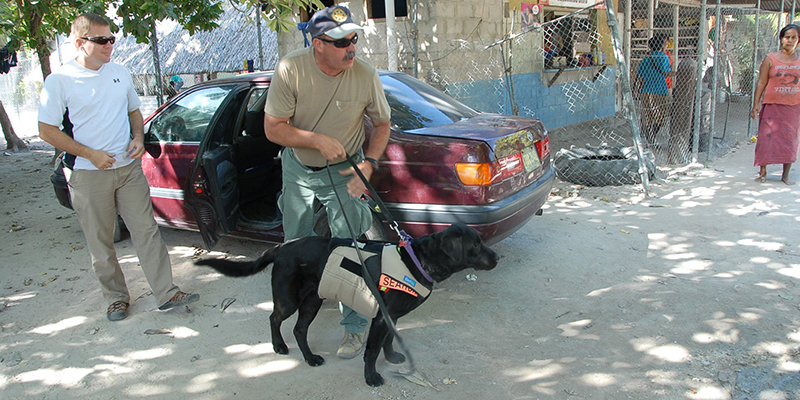
INSTALLATION OF A LIGHT POLE
REVEALS THE BONES OF OUR MISSING MARINES
For many years a nonprofit organization called History Flight had been on Betio Island looking for our missing Marines. They employed the help of forensic anthropologists, geophysicists, historians, surveyors, forensic odontologists, unexploded ordinance specialists, medics and a grave detection dog.
History Flight learned of the “lost graves of Tarawa” while searching for a downed plane in the Betio lagoon in 2006. History Flight spent thousands of hours searching archives for clues before sending teams to the island for six weeks in 2008 to locate former cemetery sites and scan them with ground penetrating radar. A break came when some utility workers on the island were in the process of digging a hole to install a light pole and found some remains of our missing Marines.
The government agency tasked with finding, identifying and repatriating the remains of missing military personnel is now called the “Defense POW/MIA Accounting Agency (DPAA). Rumor has it that DPAA had largely ignored concentrated attempts to find our missing Marines on Tarawa because the nightlife in Vietnam was so much better. In other words, the hookers were much more plentiful in the area of Vietnam, Cambodia and Laos, than they were on the forgotten Island of Tarawa in the South Pacific.
One of the missing Marines was that of 1LT Alexander “Sandy” Bonnyman who was one of four Medal of Honor recipients from the Battle of Tarawa. History Flight employing the very best technology including ground penetrating radar (GPR), backed up by a well-trained grave detection dog, finally zeroed in on the trench called cemetery 27 where Sandy Bonnyman’s remains were discovered. For seventy-two years, the official stance of the U.S. Government was that Bonnyman was buried at sea.
On May 29, 2015, forensic anthropologist Kristin Baker, based out of Hawaii, knew instantly that she had found the remains of 1LT Bonnyman because of the gold fillings which became visible as she brushed away the sand from the right side of his jaw. Most of the Marines were too young to even have cavities, but Bonnyman was considered the old man of the bunch in his late 20s to early 30s. Bonnyman was one of a two that had gold fillings in his teeth in his particular unit.
A burial list had been created which proved to be highly accurate. The list allowed History Flight to somewhat predict when and where specific individuals would be recovered. History Flight invited Clay Bonnyman Evans to be part of his grandfather’s recovery, having him arrive on Tarawa within four days of the excavation of his grandfather. He was standing there when Kristin Baker brushed the sand off his grandfather’s jaw exposing the gold fillings in his teeth.
THE UNITED STATES GOVERNMENT
INTENTIONALLY ATTEMPTS TO DERAIL SEARCH EFFORTS
History Flight had to convince a congressman of the importance of the finds they where making before the Joint POW/MIA Accounting Command (JPAC) of the U.S. Government decided to get involved. The name of this government organization has since been changed to Defense POW/MIA Accounting Agency (DPAA). This government agency sent in a team of people that included Dr. Gregory Fox.
According to people there when Fox arrived, he was a cantankerous individual who made it clear he was not happy about his assignment to Tarawa. Dr. Fox would drink heavily and seemed to care less about his job to recover our missing Marines.
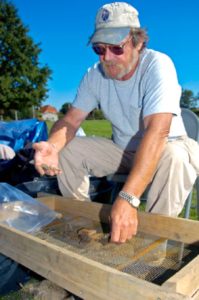
Dr. Fox made it known to a book author (Jeremy) who was on the island conducting some family research about the battles that his father had been in. Dr. Fox told this author that he, ‘wasn’t there to find no fucking Medal of Honor winner.’ When complaints were logged against Fox for his comments and attitude, the Washington swamp came in to defend Dr. Fox by intentionally not interviewing anyone who actually heard what he had said.
Dr. Fox and/or his associates in the U.S. Government actually took overt steps to discredit the work of History Flight by getting the island government to forbid History Flight from doing any digging on the island.
History Flight, in an effort to assist our government in finding our Marines suggested where they should dig based on years of exhaustive work and analysis. But, JPAC/DPAA intentionally dug in different locations knowing they would find nothing. It appeared to be an effort by the United States Government to discredit the work of History Flight. The U.S. Government went even further by encouraging the Kiribati Government to ban History Flight and anyone associated with them from their island.
The government of New Zealand had their own version of JPAC/DPAA and they were interested in finding the bodies of some New Zealanders who were spotters during the War. The government of New Zealand gave History Flight permission to look for their missing personnel and if they inadvertently found some Americans, oh well.
It appeared to some who witnessed all of these escapades, the American government did not want to find our missing Marines and were doing all they could to derail recovery efforts by History Flight or any other entity. By their actions alone one could conclude the United States Government doesn’t always want to find our missing military members. We say this with a very heavy heart.
It makes us wonder, did we leave people behind in Vietnam when we finally capitulated and went home? The saying that we never leave a fallen comrade behind may be true for our military members, but it surely isn’t true for our government. Once the battle is won and our troops are ordered to their next assignment, they can no longer search for, or initiate recovery efforts for their departed comrades. It’s up to government agencies to do that job.
In the case of Tarawa, the United States government response was absolutely disgraceful. Not only did they not wish to assist, they went out of their way to thwart finding our missing Marines. As proof of their pathetic dedication in finding our lost service personnel, JPAC/DPAA, to this very day has never used ground penetrating radar or grave detection dogs. Why is inexplicable!

